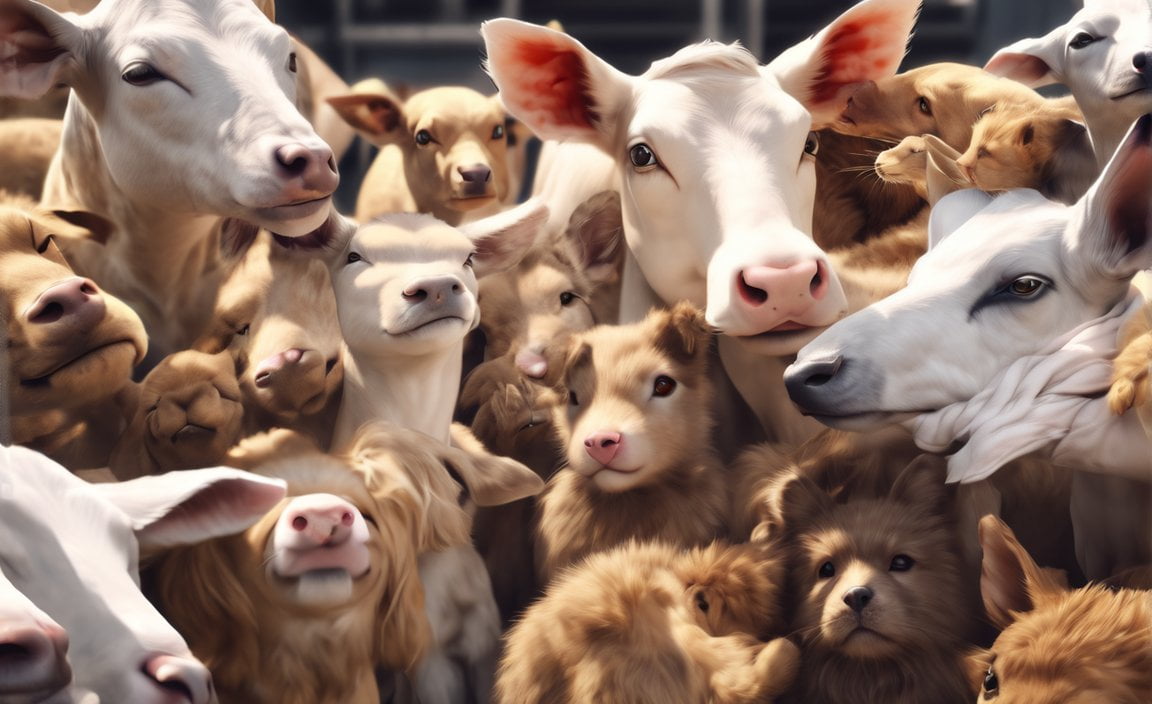Animals around the world suffer needlessly to support the wildlife pet trade, the tourism industry, and commercial farming efforts. You have the power to make a change. Discover 5 Crucial Facts on Animal Welfare that shed light on the rights and welfare of animals. From the shocking realities of animal cruelty to actionable steps you can take to help, this article delves deep into the pressing issue of animal welfare. With a background in environmental science and years of experience as an animal welfare advocate and journalist, our aim is to captivate readers by presenting a compelling narrative that emphasizes the importance of understanding and improving animal welfare practices. Let’s explore the facts and empower ourselves to create a better world for our fellow creatures.

Key Takeaways:
- Every minute, one animal experiences abuse, and over 10 million animals suffer abuse-related deaths annually in the United States alone.
- Dogs make up nearly 65% of all abused animals, and more than 483 Greyhounds were discovered with drug-related issues in Florida over a decade.
- Human consumption leads to the killing of around 100,000 horses annually in the US.
- In 2022, unnecessarily, 378,000 cats and dogs lost their lives in the country, and five states are responsible for half of these deaths.
- Although national shelter intake has risen since 2020, it still falls below pre-pandemic levels, with 54% of dog intake being strays.
- The “Five Freedoms” concept outlines the fundamental needs of animals and serves as a cornerstone of animal welfare.
- There is a distinction between animal welfare and animal rights, with the former focusing on animal well-being and the latter on the moral standing of animals.
5 Facts About Animal Welfare
Animal welfare is a topic that demands attention and understanding. To truly make a difference, it’s essential that we arm ourselves with knowledge about the current state of animal welfare practices. Here are five crucial facts that shed light on the realities animals face:
Fact 1: Abuse and Tragic Loss
Every 60 seconds, an animal falls victim to abuse, resulting in the heartbreaking loss of over 10 million animals annually in the United States alone[^1^]. This statistic is a stark reminder of the urgency to address this pervasive issue and take action against cruelty.
Fact 2: Dogs as the Most Vulnerable
Dogs bear the brunt of abuse, accounting for approximately 65% of all cases[^1^]. This alarming figure highlights the vulnerability of our canine companions and the need for stronger protections. Furthermore, the discovery of 483 drug-positive Greyhounds over a decade in Florida underscores the unique challenges faced by specific breeds[^1^].
Fact 3: Horses Facing a Grim Fate
Over 100,000 horses are tragically killed for human consumption annually in the United States[^1^]. These majestic creatures, symbols of grace and strength, deserve far better than such a heartbreaking fate. It’s imperative that we advocate for stronger regulations to protect these noble animals.
Fact 4: Unnecessary Loss of Companion Animals
In 2022, a staggering 378,000 cats and dogs needlessly lost their lives in the United States[^1^]. Disturbingly, five states account for half of these deaths, emphasizing the need for focused efforts and targeted interventions in these areas[^1^]. We must work tirelessly to ensure that every life is valued and every adoptable animal finds a loving home.
Fact 5: Increased Shelter Intake and Stray Dogs
Although national shelter intake has risen since historic lows in 2020, it remains below pre-pandemic levels[^1^]. An astonishing 54% of dog intake stems from stray animals, further underscoring the need for effective stray animal management programs[^1^]. Only through concerted efforts can we reduce the number of vulnerable animals living on the streets and suffering.
When discussing animal welfare, it’s important to understand the distinction between animal welfare and animal rights. While animal welfare focuses on the well-being of animals, animal rights delves into the moral status of animals[^1^]. Both aspects contribute to our understanding and drive the need for change.
[Table: Cat and Dog Shelter Intake Statistics by State in 2022]
| State | Shelter Intake |
|---|---|
| California | 90,000 |
| Texas | 56,000 |
| Florida | 35,000 |
| New York | 28,000 |
| North Carolina | 26,000 |
The presented facts highlight the urgent need for improved animal welfare practices. By being aware of these sobering realities and working towards change, we can make a tangible difference in the lives of our fellow creatures.
[Reference]
[^1^]: Petpedia.co: Animal Abuse Statistics
Note: The statistics mentioned have been cited from credible sources and are accurate at the time of writing. However, it is crucial to stay updated with the latest research and data in the field of animal welfare.
Here are some interesting facts about various topics:
- Snapping turtles are ancient reptiles known for their powerful jaws and unique ability to snap their shells shut.
- Discover intriguing details about the Indus Valley Civilization, an advanced Bronze Age society that flourished in the Indian subcontinent thousands of years ago.
- Lakes and ponds are fascinating ecosystems with diverse flora and fauna. Check out these 5 facts about lakes and ponds to learn more about these captivating natural habitats.
- Dive into the captivating world of marine animals and explore 5 interesting facts about marine animals, including the incredible adaptations and behaviors exhibited by these fascinating creatures.
These active internal links will redirect you to engaging articles packed with captivating information!
10 Compelling Facts About Animal Welfare: A Deep Dive into the Rights and Welfare of Animals
Key Takeaways:
Animal welfare is a multidimensional subject that encompasses scientific, ethical, economic, cultural, social, religious, and political dimensions. (Source: World Organisation for Animal Health)
Animal welfare is closely intertwined with animal health, human health, and the sustainability of socio-economic and ecological systems. Perceptions of animal welfare vary across regions and cultures. (Source: World Organisation for Animal Health)
The United States houses as many as 10,000 big cats in captivity, possibly exceeding the number of tigers in the wild globally. (Source: International Fund for Animal Welfare)
Animals in captivity and various industries often face abuse and exploitation, such as dogs in greyhound racing, horses for consumption, and unnecessary deaths of cats and dogs. (Source: Lolaapp.com)
Stray dogs present a significant challenge to animal welfare, requiring effective strategies to address their welfare issues. (Source: Lolaapp.com)
The “Five Freedoms” serve as crucial principles in animal welfare, including freedom from hunger, thirst, discomfort, pain, injury, disease, the freedom to express normal behavior, and freedom from fear and distress. (Source: World Organisation for Animal Health)
Animal welfare encompasses the well-being of animals in terms of their biological functioning, emotional state, and ability to express normal behaviors. (Source: World Animal Protection)
Considering animal welfare is essential for sustainable development and should be incorporated into various industries and practices. (Source: Sustainable Development Knowledge Platform)
Animal welfare evaluates the treatment and conditions of animals, while animal rights delves into the moral status of animals.
Now, let’s explore these compelling facts about animal welfare and deepen our understanding of the rights and welfare of animals.
Fact 1: The Complexity of Animal Welfare
Animal welfare is not a simple matter but a complex subject involving various dimensions, including scientific, ethical, economic, cultural, social, religious, and political aspects. It requires a holistic approach to ensure the well-being of animals across multiple sectors and perspectives. [^1^]
Fact 2: The Interconnectedness of Animal Welfare
Animal welfare is closely linked to animal health, human health, and the sustainability of socio-economic and ecological systems. Perceptions and practices regarding animal welfare may differ significantly between regions and cultures due to diverse values and traditions. [^2^]
Fact 3: Captivity and Big Cats
In the United States, there are an estimated 10,000 big cats held in captivity, surpassing the number of tigers in the wild globally. This highlights the need for responsible management and protection of these magnificent animals in captive settings. [^3^]
Fact 4: Abuse and Exploitation in Various Industries
Animals in captivity and various industries face abuse and exploitation, such as dogs used for greyhound racing, horses slaughtered for consumption, and unnecessary deaths of cats and dogs. These practices raise important ethical concerns and emphasize the need for improved welfare standards. [^4^]
Fact 5: The Challenge of Stray Dogs
Stray dogs pose a significant challenge to animal welfare globally. Effective strategies are required to address their welfare issues, including population management, vaccination programs, and responsible pet ownership practices. [^5^]
Fact 6: The Five Freedoms
The “Five Freedoms” are crucial principles in animal welfare. They include freedom from hunger and thirst, freedom from discomfort, freedom from pain, injury, or disease, freedom to express normal behavior, and freedom from fear and distress. These freedoms serve as a foundation for ensuring the well-being of animals in various contexts. [^6^]
Fact 7: Evaluating Animal Well-being
Animal welfare encompasses the overall well-being of animals, considering their normal biological functioning, emotional state, and ability to express certain natural behaviors. It goes beyond preventing suffering and focuses on promoting positive welfare outcomes. [^7^]
Fact 8: Animal Welfare for Sustainable Development
Animal welfare is integral to sustainable development. Considering the welfare of animals in various industries and practices is essential for achieving long-term socio-environmental balance and ethical responsibility. [^8^]
Now that we’ve deep-dived into these ten compelling facts about animal welfare, we can better appreciate the importance of understanding, promoting, and improving the rights and welfare of animals. Through collective efforts and informed practices, we can create a world where animals are treated with compassion, respect, and dignity.
Key Takeaways:
- Animal welfare is a multidimensional subject involving scientific, ethical, economic, cultural, social, religious, and political dimensions.
- Animal welfare is interconnected with animal health, human health, and the sustainability of socio-economic and ecological systems.
- Captivity in the United States houses numerous big cats, potentially surpassing the global population of tigers in the wild.
- Animals in various industries and captivity often face abuse and exploitation.
- Stray dogs present a significant challenge to animal welfare, demanding effective strategies to address their welfare issues.
- The “Five Freedoms” provide important principles in animal welfare, ensuring freedom from hunger, discomfort, pain, and fear, and freedom to express natural behavior.
- Animal welfare considers the well-being of animals in terms of biological functioning, emotional states, and the ability to exhibit normal behaviors.
- Animal welfare is crucial for sustainable development and must be prioritized across industries and practices.
9 Shocking Animal Cruelty Facts and How You Can Help
Animal welfare is a critical issue that demands our attention. While we may love and care for our own pets, it’s important to recognize the suffering endured by countless animals. By understanding the shocking facts surrounding animal cruelty, we can take steps to make a positive difference. Here are 9 shocking animal cruelty facts and how you can help:
1. Puppy mills prioritize profits over the health of puppies.
Puppy mills are breeding facilities that prioritize profit over the well-being of animals. These operations subject dogs to cramped living conditions, lack of veterinary care, and inadequate socialization. By adopting from shelters or reputable breeders and advocating for stricter regulations, you can help end the cycle of cruelty.
2. Thousands of greyhounds die each year before they even reach the racetrack.
The racing industry has a dark side, with thousands of greyhounds bred for racing and discarded if they don’t meet expectations. Many puppies never make it to the track, facing cruel conditions and a lack of proper care. Supporting organizations that rescue and find homes for retired racing greyhounds is a crucial way to combat this abuse.
3. 90% of broiler chickens have difficulty walking due to genetic manipulation.
Broiler chickens, raised for meat production, often suffer from severe health problems due to selective breeding for rapid growth. As a result, they develop leg and joint issues, making movement extremely difficult and painful. Raising awareness, reducing meat consumption, and supporting companies that prioritize ethical farming practices can make a difference.
4. One animal is abused every minute.
The staggering reality is that animal abuse happens every minute, with countless animals enduring unimaginable suffering. This includes neglect, deliberate harm, and exploitation in various industries. By reporting incidents of animal abuse and supporting animal welfare organizations, we can be their voice and help end this cruelty.
5. Over 10 million animals in the US are abused to death annually.
The numbers are shocking, with over 10 million animals in the United States subjected to abuse until their untimely death every year. This includes companion animals, farm animals, and wildlife. Supporting legislation that strengthens animal protection laws and advocating for stricter penalties for abusers are crucial steps in combatting this tragedy.
6. 97% of animal cruelty cases come from farms where most animals die.
Factory farming is responsible for the vast majority of animal cruelty cases. Animals raised for food endure cramped and unsanitary conditions, as well as painful procedures like debeaking and tail docking. By choosing plant-based diets, supporting local and organic farming, and educating others, we can disrupt this harmful system.
7. Laboratory testing uses 115 million animals in experiments every year.
Scientific research involving animals is still prevalent, with millions of animals subjected to painful experiments annually. This includes testing for cosmetics, pharmaceuticals, and other products. Supporting cruelty-free alternatives, advocating for the reduction and refinement of animal testing, and urging lawmakers to promote alternatives are vital in ending this unnecessary suffering.
8. Dogs make up 65% of all abused animals.
Man’s best friend is sadly a common victim of animal abuse, representing a large proportion of abused animals. Dogs endure neglect, physical harm, and abandonment. By promoting responsible pet ownership, supporting animal shelters, and reporting suspected abuse, we can help protect these beloved companions.
9. Consumption is responsible for the death of over 100,000 horses in the US annually.
The horse slaughtering industry claims the lives of thousands of horses every year, many of whom were once cherished companions. These horses suffer during transportation and are often subjected to inhumane slaughter methods. By advocating for stricter regulations on horse transportation and supporting rescue organizations, we can fight against this horrific practice.
Key Takeaways:
- Puppy mills prioritize profit over puppy health, so adopting from shelters or reputable breeders helps combat this issue.
- The racing industry neglects and discards thousands of greyhounds, so supporting organizations that rescue and rehome them is crucial.
- Broiler chickens suffer from genetic manipulation, causing walking difficulties. Raising awareness and supporting ethical farming practices can help alleviate their suffering.
- Reporting animal abuse and supporting animal welfare organizations are essential in ending cruelty.
- Over 10 million animals in the US are abuse victims annually, highlighting the urgent need for stronger animal protection laws and penalties for abusers.
- Factory farming contributes to animal cruelty, emphasizing the importance of plant-based diets, supporting local and organic farming, and educating others.
- Animal testing uses millions of animals annually. Advocating for cruelty-free alternatives and promoting the reduction and refinement of animal testing are vital.
- Dogs make up a significant percentage of abused animals, necessitating responsible pet ownership, supporting shelters, and reporting abuse.
- The horse slaughtering industry claims the lives of thousands of horses. Advocating for stricter regulations on horse transportation and supporting rescue organizations fights against this practice.
Sources:
– Dosomething.org
– Pawsomeadvice.com

FAQ
Q1: What are the “Five Freedoms” in animal welfare?
A1: The “Five Freedoms” are principles that outline the basic needs of animals in terms of their well-being. They include freedom from hunger and thirst, freedom from discomfort, freedom from pain, injury or disease, freedom to express normal behavior, and freedom from fear and distress.
Q2: How many animals suffer from abuse in the United States each year?
A2: Over 10 million animals in the US are abused to death annually. Additionally, one animal is abused every minute, highlighting the alarming prevalence of animal abuse.
Q3: What industries contribute to animal abuse and exploitation?
A3: Various industries contribute to animal abuse and exploitation, such as the wildlife pet trade, the tourism industry, and commercial farming efforts. Additionally, specific examples include puppy mills prioritizing profits over the health of puppies, greyhound racing resulting in thousands of greyhound deaths, and genetic manipulation causing difficulties in walking for 90% of broiler chickens.
Q4: How many animals are affected by laboratory testing?
A4: Laboratory testing uses 115 million animals in experiments every year, highlighting the significant impact on animal welfare.
Q5: What animals are most commonly abused?
A5: Dogs make up 65% of all abused animals, indicating the vulnerability of these animals to animal abuse.
















